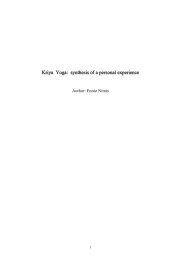Chapter 4
Chapter 4
Chapter 4
You also want an ePaper? Increase the reach of your titles
YUMPU automatically turns print PDFs into web optimized ePapers that Google loves.
(3) Divide the space into different regions associated with the charge distribution. For<br />
each re gion, calculate q , the charge enclosed by the Gaussian surface.<br />
enc<br />
(4) Calculate the electric flux E through the Gaussian surface for each region.<br />
Φ<br />
(5) Equate E Φ with qenc / ε 0 , and deduce the magnitude of the electric field.<br />
Example 4.1: Infinitely Long Rod of Uniform<br />
Charge Density<br />
An infinite ly long rod of negligible radius has a uniform charge density λ . Calculate the<br />
electric field at a distance r from the wire.<br />
Solution:<br />
We shall solve the problem by following the steps outlined above.<br />
(1) An infinitely long rod possesses cylindrical symmetry.<br />
(2) The charge density is uniformly distributed throughout the length,<br />
and the electric<br />
eld E must be point radially away from the symmetry axis of the rod (Figure 4.2.6).<br />
The m gnitude of the electric field is constant on cylindrical surfaces of radius .<br />
Therefore, we choose a coaxial cylinder as our Gaussian surface.<br />
<br />
fi<br />
a r<br />
Figure 4.2.6 Field lines for an infinite uniformly charged rod (the symmetry axis of the<br />
rod and the Gaussian cylinder are perpendicular to plane of the page.)<br />
(3) The amount of charge enclosed by the Gaussian surface, a cylinder of radius r and<br />
length (Figure 4.2.7), is q = λ<br />
.<br />
enc<br />
7

















